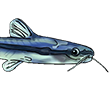Jonathan W. Armbruster, Lauren Greene, and Nathan K. Lujan (2018) Using Morphology to Test DNA-Based Phylogenetic Relationships within the Guiana Shield Catfish Tribe Lithoxini (Siluriformes: Loricariidae). Copeia: December 2018, Vol. 106, No. 4, pp. 671-680.
http://www.asihcopeiaonline.org/doi/abs ... /CI-18-121
ABSTRACT
As DNA-based phylogenetic analyses have exploded, historically phenotype-based evolutionary hypotheses throughout the tree of life have been rewritten. However, rarely are DNA-based phylogenetic hypotheses tested via the reanalysis of phenotypic data. Skeletons representing all four recognized genera of the Guiana Shield endemic suckermouth armored catfish clade Lithoxini were examined to test a recently published DNA-based phylogenetic hypothesis using morphological evidence. Phylogenetic analysis of 54 mostly osteological characters yielded a single most parsimonious tree of 90 steps that was congruent with the molecular hypothesis: (Avalithoxus, ((Exastilithoxus), (Lithoxus, Paralithoxus))). Lithoxini was a well-supported clade with 20 synapomorphies, as was each of the genera within this clade. Avalithoxus jantjae, which was originally described in Lithoxus, was found to be missing the unique synapomorphies of Lithoxus + Paralithoxus: a spoon-shaped, ventrally oriented process on the metapterygoid and a process on the preoperculo-hyomandibular ridge.
Using Morphology to Test DNA-Based Phylogenetic Relationships within the Lithoxini
- bekateen
- Posts: 9649
- Joined: 09 Sep 2014, 17:50
- I've donated: $40.00!
- My articles: 4
- My images: 143
- My cats species list: 146 (i:106, k:34)
- My aquaria list: 41 (i:18)
- My BLogs: 44 (i:154, p:2563)
- My Wishlist: 36
- Spotted: 184
- Location 1: USA, California, Stockton
- Location 2: USA, California, Stockton
- Contact:
Using Morphology to Test DNA-Based Phylogenetic Relationships within the Lithoxini
Find me on YouTube & Facebook: http://youtube.com/user/Bekateen1; https://www.facebook.com/Bekateen
Buying caves from https://plecocaves.com? Plecocaves sponsor Bekateen's Fishroom. Use coupon code bekateen for 15% off your order. Also, for you Swifties: Https://youtu.be/ZUKdhXL3NCw
-
Bas Pels
- Posts: 2918
- Joined: 21 Dec 2006, 20:35
- My images: 1
- My cats species list: 28 (i:0, k:0)
- Spotted: 8
- Location 1: the Netherlands
- Location 2: Nijmegen the Netherlands
- Interests: Central American and Uruguayan fishes
Re: Using Morphology to Test DNA-Based Phylogenetic Relationships within the Lithoxini
Nice to know genetics suits morphological data. I wonder how often such a test is done.
It might surprize many people, I once graduated in chemistry, but I think a tree based on genetics is nice, however, I rather have one - also - based on morphology.
The thing is, genetics is a message in four letters, ACTG. A can switch into T and back and C into G and back. A to C happens a lot less, and the other way around.
But when I compare 2 species, 1 has A and the other T - I don't see how many A-T-A-T switches have been made.
Morphology does not have this problem. Therefore I'd like to see a morphological confirmation of genetics every now and then.
It might surprize many people, I once graduated in chemistry, but I think a tree based on genetics is nice, however, I rather have one - also - based on morphology.
The thing is, genetics is a message in four letters, ACTG. A can switch into T and back and C into G and back. A to C happens a lot less, and the other way around.
But when I compare 2 species, 1 has A and the other T - I don't see how many A-T-A-T switches have been made.
Morphology does not have this problem. Therefore I'd like to see a morphological confirmation of genetics every now and then.
cats have whiskers
- racoll
- Posts: 5258
- Joined: 26 Jan 2004, 12:18
- My articles: 6
- My images: 182
- My catfish: 2
- My cats species list: 2 (i:2, k:0)
- My aquaria list: 1 (i:0)
- Spotted: 238
- Location 1: London
- Location 2: UK
Re: Using Morphology to Test DNA-Based Phylogenetic Relationships within the Lithoxini
Not quite true, morphological evolution very much suffers from the phenomenon that you describe, as well rampant homoplasy (shared character states in unrelated species, such as spoon shaped teeth in and ). The difference is that molecular evolution is well enough understood to be able to effectively mitigate these problem with the use of explicit substitution models that have been around since the early 1980s. Morphological evolution is not well enough understood yet to be able to effectively model it in this way.The thing is, genetics is a message in four letters, ACTG. A can switch into T and back and C into G and back. A to C happens a lot less, and the other way around.
But when I compare 2 species, 1 has A and the other T - I don't see how many A-T-A-T switches have been made.
Morphology does not have this problem. Therefore I'd like to see a morphological confirmation of genetics every now and then.






